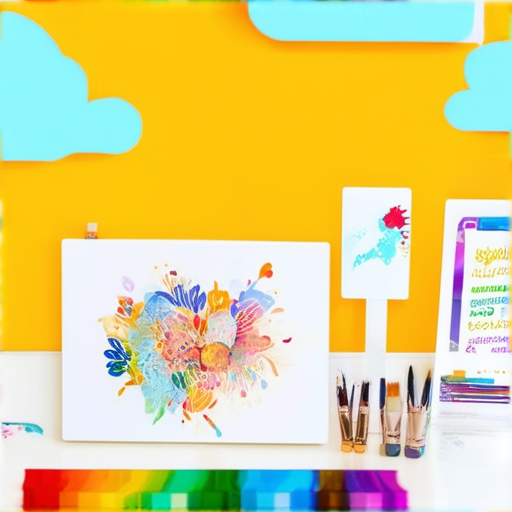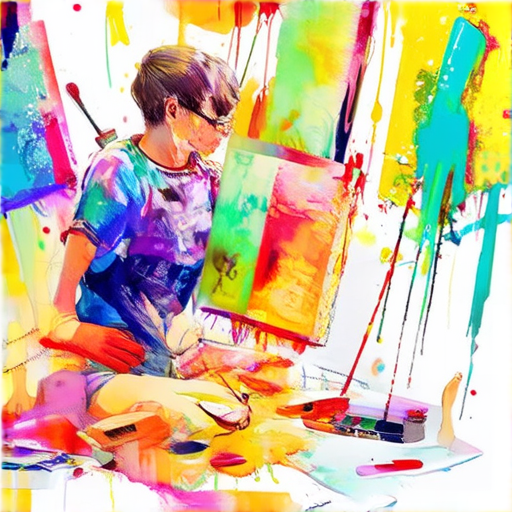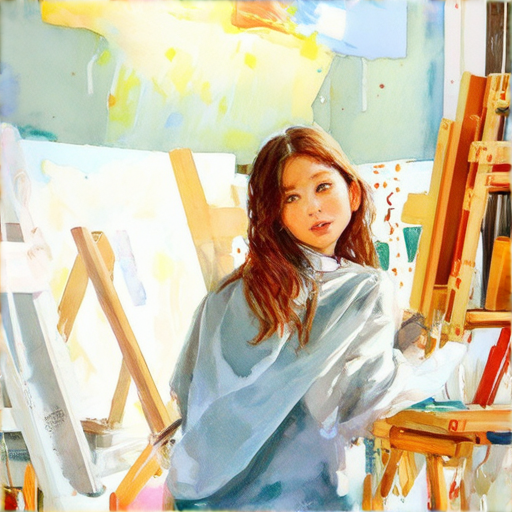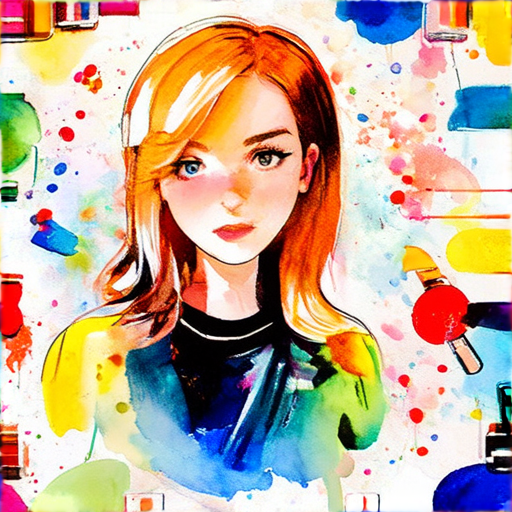Discover the world of art-making from the comfort of your own home, where creativity knows no bounds and mistakes become opportunities for growth. If you’re new to the world of art, finding the right starting point can be overwhelming – but fear not, as we’re about to embark on a journey to explore the easiest art to start with, perfect for those looking to unleash their inner artist without feeling intimidated by complex techniques or expensive materials.

The Easiest Art to Start With
We believe that everyone can unleash their creativity and express themselves through various forms of art.
- Drawing: Drawing is a fundamental skill that can be developed with practice and patience. It’s an excellent way to relax and tap into your imagination.
- Painting: Painting is another popular art form that allows you to experiment with colors and techniques. You can start with simple watercolor painting or acrylics.
- Collage: Collage is a fun and easy art form that involves creating images using cut-out pieces of paper or other materials.
- Sculpture: Sculpture is a three-dimensional art form that involves shaping and molding materials like clay, wood, or metal.
Why Choose These Arts?
These arts are great for beginners because they require minimal equipment and can be done in a short amount of time. They’re also versatile and allow you to experiment with different styles and techniques.
- Flexibility: These arts offer flexibility in terms of medium, style, and subject matter. You can choose what works best for you and your schedule.
- Cost-effective: Most of these arts don’t require expensive equipment or supplies. You can start with basic materials and gradually upgrade as you become more comfortable.
- Relaxation: Engaging in these arts can be therapeutic and help reduce stress. They allow you to focus on the present moment and express yourself creatively.
Getting Started
To get started, simply choose an art form that interests you and begin experimenting. Don’t worry too much about making mistakes – they’re an essential part of the learning process. As you progress, you can always seek guidance from online tutorials, books, or local classes.
Remember, the most important thing is to have fun and enjoy the process of creating something new and unique. Happy crafting!
Starting Art for Beginners
As a beginner, getting started with art can seem daunting, but with the right approach, you can unlock your creative potential and enjoy the process.
-
Understand Your Goals
Determine what type of art you want to create, whether it’s painting, drawing, sculpting, or something else. Knowing your goals will help you choose the right tools and techniques.
-
Gather Essential Tools
You don’t need to invest in expensive equipment to get started. Basic supplies like pencils, erasers, paper, and paints are sufficient for most artistic endeavors.
-
Practice Regularly
The key to improving your art skills is consistent practice. Set aside time each day or week to work on your craft, even if it’s just for a few minutes.
-
Learn from Others
Study the work of other artists, both past and present. Analyze their techniques, styles, and compositions to gain insight and inspiration.
-
Experiment and Take Risks
Don’t be afraid to try new things and take risks in your art. Experimentation is essential for growth and development as an artist.
-
Join a Community
Connecting with fellow artists can be motivating and helpful. Join online forums, local art groups, or classes to share your work and receive feedback.
-
Be Patient and Persistent
Artistic progress takes time, effort, and dedication. Stay committed to your craft, and you’ll see improvements over time.
At Pravylo Project, we believe that everyone has the potential to become an artist. Our platform offers a range of resources, tutorials, and inspiration to help you get started and continue growing as an artist.
We recommend checking out our DIY Guides section for step-by-step instructions on various art projects, from painting to crafting.
Additionally, you may find our Community Forum section useful for connecting with other artists, sharing your work, and receiving feedback.
Remember, the journey to becoming an artist is unique to each individual. Stay true to your vision, and with persistence and patience, you’ll achieve your artistic goals.

The 7 Fundamentals of Art
The 7 fundamentals of art are the essential components that artists use to create visually appealing and meaningful pieces.
-
Line
A line is a continuous mark made on a surface by a drawing tool. Lines can vary in width, length, direction, and curvature, and are used to define shape, form, and movement in a composition.
-
Shape
A shape is a self-contained area with a defined boundary. Shapes can be geometric, such as squares and circles, or organic, such as free-form shapes found in nature.
-
Space
Space refers to the negative areas between and around objects in a composition. Artists use space to create a sense of depth, distance, and atmosphere in their work.
-
Value
Value refers to the lightness or darkness of a color or object. Artists use value to create contrast, mood, and visual interest in their compositions.
-
Form
Form refers to the three-dimensional qualities of an object or shape. Form can be created through the use of lines, shapes, and values, and is used to convey volume, mass, and texture.
-
Texture
Texture refers to the surface quality or “feel” of an object or material. Artists use texture to create tactile sensations, add visual interest, and convey emotion in their work.
-
Color
Color is the property of an object that is perceived by the eye as a result of the way it reflects or emits light. Artists use color to create mood, express emotion, and communicate meaning in their compositions.
By mastering these 7 fundamentals of art, artists can create powerful and expressive works that engage and inspire audiences.

What is the Easiest Thing to Paint as a Beginner?
I’m excited to share my favorite easy painting ideas perfect for beginners.
- Simple Still Life Setups: Try painting everyday objects like fruit, flowers, or household items. These subjects are great for practicing color and composition.
- Abstract Designs: Get creative with abstract art! Use bold colors and expressive brushstrokes to create unique pieces that reflect your personality.
- Geometric Patterns: Geometric shapes are a great way to practice pattern-making and repetition. Try painting chevrons, polka dots, or stripes.
- Landscape Painting with Broad Brushstrokes: Capture the beauty of nature with loose, expressive brushstrokes. Focus on capturing the mood and atmosphere of the scene rather than precise details.
Remember, the most important thing is to have fun and enjoy the process of creating!
Practicing with Simple Subjects
- Start with simple subjects like lemons, apples, or potted plants.
- Practice painting basic shapes and forms, like spheres, cylinders, and rectangles.
- Experiment with different brushstrokes and textures to add interest to your paintings.
Tips for Beginners
- Don’t worry too much about making mistakes – they’re an opportunity to learn and grow!
- Practice regularly to develop your skills and confidence.
- Watch online tutorials and take classes to learn new techniques and gain inspiration.
Getting Started with Art Supplies
You don’t need to invest in expensive art supplies to get started. Here are some basics to consider:
- A set of acrylic paints or watercolors
- A variety of brushes in different sizes and shapes
- A canvas or paper specifically designed for painting
- A palette or plate for mixing colors
Remember, the most important thing is to have fun and enjoy the process of creating!
Getting Started with Painting: A Beginner’s Guide
I’m excited to share my passion for painting with you, and I’m confident that with these steps, you’ll be well on your way to creating beautiful artwork.
-
Step 1: Gather Essential Supplies
You don’t need to spend a fortune on art supplies, but having the basics will get you started. Invest in a few high-quality paints, brushes, canvases, and easels. Some popular options include:
- Cheap paint sets from Amazon ($20-$50)
- Winsor & Newton Cotman Watercolors ($30-$60)
- Daler-Rowney System 3 Acrylic Paints ($40-$80)
-
Step 2: Choose Your Medium
Decide which type of painting suits you best: oil, acrylic, watercolor, or mixed media. Each has its own unique characteristics and challenges.
- Oils: Great for blending colors and achieving rich textures
- Acrylics: Fast-drying and versatile, perfect for beginners
- Watercolors: Delicate and transparent, ideal for landscapes and florals
-
Step 3: Learn Basic Techniques
Practice fundamental skills like color mixing, brushstrokes, and composition. Watch online tutorials, take classes, or join a local art group to learn from experienced artists.
- YouTube channels like Proko and Art Camp offer excellent tutorials
- The Art Students League of New York provides affordable classes and workshops
- Your local art supply store may host free demonstrations and events
-
Step 4: Experiment and Practice
Don’t be afraid to try new things and make mistakes. Set aside time each week to paint and experiment with different techniques and mediums.
- Start with simple exercises like color charts and gesture drawings
- Gradually move on to more complex subjects like still-life compositions and portraits
- Join online communities or forums to connect with fellow artists and get feedback
-
Step 5: Display and Share Your Work
Showcase your creations proudly! Share your artwork on social media, participate in local exhibitions, or gift your pieces to friends and family.
- Instagram and Facebook are great platforms to showcase your art
- Local galleries and art fairs can provide valuable exposure
- Consider selling your work through online marketplaces or local art stores
Remember, the most important thing is to have fun and enjoy the process of creating. Happy painting!

Choosing Between Watercolor and Acrylic for Beginners
We understand that selecting the perfect art medium can be overwhelming, especially for those just starting out.
- Watercolor: Known for its translucent and fluid properties, watercolor paint is ideal for creating delicate, ethereal pieces.
- Acrylic: A versatile and fast-drying option, acrylic paint offers vibrant colors and a wide range of techniques to experiment with.
Easier for Beginners?
While both mediums have their unique characteristics, we believe that acrylic paint is generally easier for beginners to work with due to its:
- Versatility: Acrylic paint can be used to create a variety of effects, from thin watery layers to thick textured strokes.
- Durability: Unlike watercolor, which can be prone to bleeding or fading, acrylic paint dries quickly and retains its color intensity.
- Longer Working Time: Acrylic paint allows artists to work on a piece for an extended period without worrying about the paint drying too quickly.
Practical Tips for Beginners
To get started with acrylic paint, consider the following tips:
- Start with basic colors: Invest in a starter set of primary colors and learn how to mix them to create a wide range of hues.
- Experiment with techniques: Try out different brushstrokes, layering methods, and texture techniques to find what works best for you.
- Practice regularly: Set aside time each week to practice painting and experimenting with new techniques.
Community Resources
For more information and inspiration, check out our DIY Guides and Community Forums for tips and advice from fellow artists.
Conclusion
We hope this guide has helped you decide between watercolor and acrylic paint for your artistic journey. Remember to always practice patience, persistence, and experimentation – and most importantly, have fun!

0 Comments